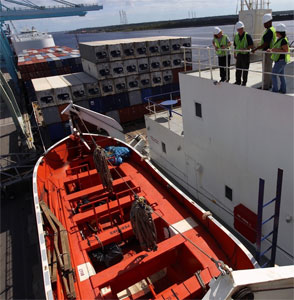A yearlong U.S. Coast Guard inspection of 122 open lifeboats on 45 U.S.-flagged ships revealed numerous deficiencies. However, the service does not plan to mandate the removal of these boats from domestic vessels.
When asked why the Coast Guard will not end the use of open lifeboats, spokeswoman Lt. Amy Midgett referenced the service’s final action memorandum on the 2015 sinking of the cargo ship El Faro. In the memo, released on Dec. 19, 2017, then-commandant Adm. Paul Zukunft wrote that “the Coast Guard agrees that open lifeboats should be phased out of operation and supports proposals from vessel owners and operators or legislation to accomplish this.”
Zukunft also referenced a Coast Guard proposal from 1989 to retrofit all oceangoing vessels with enclosed lifeboats by July 1, 2001. “However, due to cost-benefit and competitiveness concerns, and insufficient support at (the International Maritime Organization) for a similar U.S. proposal, the requirement was removed” from a final rule on the issue, he wrote.
“The same limitations would prevent a current regulatory initiative from succeeding,” Midgett said. “As such, the (Coast Guard) continues to support non-regulatory strategies such as the concentrated inspection campaign (CIC) to achieve the same result. (The Coast Guard) has worked with many owners/operators to upgrade their lifeboats voluntarily.”
As a result, open lifeboats are still allowed on U.S.-flagged vessels built before July 1, 1986. The Coast Guard does not have an updated cost estimate to replace all remaining open lifeboats, Midgett said. Modern, enclosed lifeboats were required in a 1983 amendment to the Safety of Life at Sea (SOLAS) regulations, which does not apply to U.S.-flagged oceangoing vessels on domestic routes.
The Coast Guard’s yearlong inspection campaign to make sure open lifeboats are still serviceable ended May 1. It focused on recordkeeping, crew proficiency and the condition of lifeboats, according to the service.
During the inspection, 68 problems were found on 35 of the 122 lifeboats. Deficiencies included visible cracks on the hull, wastage of davits, delamination and cracking on various components, inoperable winches, and oil leaks. Because of where some of the ships were moored, 14 of the 45 vessels could not launch, maneuver and recover every open lifeboat on board. These remaining boats must be launched later in front of a Coast Guard marine inspector. Open lifeboats will be inspected annually.
The safety of open lifeboats drew scrutiny during investigations of the sinking of El Faro, which had two open davit-launched lifeboats. However, the feasibility of launching any lifeboat, open or enclosed, on El Faro during Hurricane Joaquin has been questioned. Because davit-launched lifeboats are located on the side of a ship, the degree of list is crucial.
“Generally, when you get past 18 degrees of list, they’re impossible to launch,” said Capt. Jon Kjaerulff, business development manager at MITAGS-PMI, which specializes in maritime safety and emergency response training. “If you wait too long and the ship is listing beyond that, along the high side, gravity won’t work to take it down like it should, and on the low side, it’s hanging out too far to be able to board it.”
At the time the El Faro crew was trying to deploy the lifeboats, the vessel was listing in excess of 15 degrees, and possibly 18 degrees, according to the Coast Guard’s Marine Board of Investigation report. The lifeboats were “designed to operate with a list up to 15 degrees with a fully loaded boat,” the board stated.
Lawrence Brennan, a former U.S. Navy captain and a law professor at Fordham University, said that the cost of the lifeboats should not be a factor. With an enhanced, enclosed lifeboat, he said that mariners “have a chance. And that’s the difference. What’s the cost per lifeboat?”
Although industry members and insurers should be part of the rule change requiring enclosed lifeboats, it is ultimately up to the Coast Guard, Brennan said.
“I think the Coast Guard needs to assert leadership and not defer to parties who are regulated,” Brennan said. “The regulators should be the leaders. I mean, there’s no factual dispute.”

